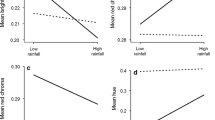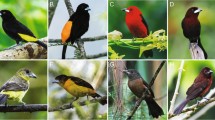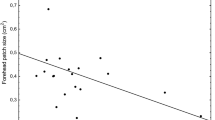Abstract
Colorful ornaments in birds are often sexually selected signals of quality, and variation in ornament expression may be mediated by physiological stress through the secretion of corticosterone. However, testing for links between ornamentation and corticosterone often requires sampling live animals, and such physiological measures may not be matched in the time span in which they were sampled (e.g., very dynamic plasma corticosterone vs. plumage coloration, which is relatively static). Here, we use museum specimens to test for a link between the color of a sexual ornament and feather corticosterone at the time of ornament formation. In red-winged blackbirds, Agelaius phoeniceus, carotenoid-based epaulets appear to be important in male–male social interactions, territory maintenance, and female choice. We measured reflectance spectra of adult male epaulets and plucked adjacent feathers for corticosterone analysis via radioimmunoassay. We controlled for differences in the number of mates, specimen age, and geography by selecting only males with one mate and only birds collected in Florida during a 3-year period. Epaulet hue and red chroma did not vary with feather corticosterone, but males whose epaulets scored high for mean brightness and red brightness had significantly lower corticosterone than males with low brightness scores. This correlation with brightness but not hue or chroma is consistent with an effect of corticosterone (CORT) on feather microstructure, with elevated CORT leading to lower reflectance of white light from the keratin matrix surrounding the carotenoid pigments.

Similar content being viewed by others
References
Andersson M (1994) Sexual selection. Princeton University Press, Princeton
Barbosa AM, Palacios J, Valera F, Martinez A (2012) Geographic variation in beak colouration in gentoo penguins Pygoscelis papua. Polar Biol 35:725–731
Beletsky L (1996) The red-winged blackbird. Academic, London
Bendich A, Olson JA (1989) Biological actions of carotenoids. FASEB J 3:1927–1932
Bercovitch FB (1996) Testicular function and scrotal coloration in patas monkeys. J Zool Lond 239:93–100
Berger S, Martin Ii LB, Wikelski M, Romero LM, Kalko EKV, Vitousek MN, Rödl T (2005) Corticosterone suppresses immune activity in territorial Galápagos marine iguanas during reproduction. Horm Behav 47:419–429
Bonier F, Moore IT, Martin PR, Robertson RJ (2009a) The relationship between fitness and baseline glucocorticoids in a passerine bird. Gen Comp Endocr 163:208–213
Bonier F, Martin PR, Moore IT, Wingfield JC (2009b) Do baseline glucocorticoids predict fitness? Trends Ecol Evol 24:634–642
Bortolotti GR, Marchant TA, Blas J, German T (2008) Corticosterone in feathers is a long-term, integrated measure of avian stress physiology. Funct Ecol 22:494–500
Bortolotti GR, Marchant T, Blas J, Cabezas S (2009a) Tracking stress: localization, deposition and stability of corticosterone in feathers. J Exp Biol 212:1477–1482
Bortolotti GR, Mougeot F, Martinez-Padilla J, Webster LMI, Piertney SB (2009b) Physiological stress mediates the honesty of social signals. PLoS ONE 4:e4983
Chew BP, Park JS (2004) Carotenoid action on the immune response. J Nutr 134:257S–261S
Costantini D, Marasco V, Møller AP (2011) A meta-analysis of glucocorticoids as modulators of oxidative stress in vertebrates. J Comp Physiol B 181:447–456
DesRochers DW, Reed JM, Awerman J, Kluge JA, Wilkinson J, van Griethuijsen LI, Aman J, Romero LM (2009) Exogenous and endogenous corticosterone alter feather quality. Comp Biochem Physiol A 152:46–52
Doucet SM, Hill GE (2009) Do museum specimens accurately represent wild birds? A case study of carotenoid, melanin, and structural colours in long-tailed manakins Chiroxiphia linearis. J Avian Biol 40:146–156
Dunlap KD, Schall JJ (1995) Hormonal alterations and reproductive inhibition in male fence lizards (Sceloporus occidentalis) infected with the malarial parasite Plasmodium mexicanum. Physiol Zool 68:608–621
Goodwin TE, Broederdorf LJ, Burkert BA, Hirwa IH, Mark DB, Waldrip ZJ, Kopper RA, Sutherland MV, Freeman EW, Hollister-Smith JA, Schulte BA (2012) Chemical signals of elephant musth: temporal aspects of microbially-mediated modifications. J Chem Ecol 38:81–87
Hansen AJ, Rohwer S (1986) Coverable badges and resource defense in birds. Anim Behav 34:69–76
Harding AMA, Welcker J, Steen H, Hamer KC, Kitaysky AS, Fort J, Talbot SL, Cornick LA, Karnovsky NJ, Gabrielsen GW, Grémillet D (2011) Adverse foraging conditions may impact body mass and survival of a high Arctic seabird. Oecologia 167:49–59
Harms NJ, Fairhurst GD, Bortolotti GR, Smits JEG (2010) Variation in immune function, body condition, and feather corticosterone in nestling tree swallows (Tachycineta bicolor) on reclaimed wetlands in the Athabasca oil sands, Alberta, Canada. Environ Pollut 158:841–848
Husak JF, Moore IT (2008) Stress hormones and mate choice. Trends Ecol Evol 23:532–534
Jacot A, Romero-Diaz C, Tschirren B, Richner H, Fitze PS (2010) Dissecting carotenoid from structural components of carotenoid-based coloration: a field experiment with great tits (Parus major). Am Nat 176:55–62
Jouventin P, McGraw KJ, Morel M, Celerier A (2007) Dietary carotenoid supplementation affects orange beak but not foot coloration in gentoo penguins Pygoscelis papua. Waterbirds 30:573–578
Kitaysky AS, Kitaiskaia EV, Wingfield JC, Piatt JF (2001) Dietary restriction causes chronic elevation of corticosterone and enhances stress response in red-legged kittiwake chicks. J Comp Physiol B 171:701–709
Kodric-Brown A (1989) Dietary carotenoids and male mating success in the guppy: an environmental component to female choice. Behav Ecol Sociobiol 25:393–401
Koren L, Nakagawa S, Burke T, Soma KK, Wynne-Edwards KE, Geffen E (2012) Non-breeding feather concentrations of testosterone, corticosterone and cortisol are associated with subsequent survival in wild house sparrows. Proc R Soc Lond B 279:1560–1566
Krinsky NI (2001) Carotenoids as antioxidants. Nutrition 17:815–817
Lattin CR, Reed LM, DesRochers DW, Romero LM (2011) Elevated corticosterone in feathers correlates with corticosterone-induced decreased feather quality: a validation study. J Avian Biol 42:247–252
Linz GM, Bolin SB, Cassel JF (1983) Postnuptial and postjuvenal molts of red-winged blackbirds in Cass County, North Dakota. Auk 100:206–209
Matrková J, Remes V (2012) Environmental and genetic effects on pigment-based vs. structural component of yellow feather colouration. PLoS ONE 7:e36640
McGraw KJ (2005) The antioxidant function of many animal pigments: are there consistent health benefits of sexually selected colourants? Anim Behav 69:757–764
McGraw KJ (2006) Mechanics of carotenoid-based coloration. In: Hill GE, McGraw KJ (eds) Bird coloration: mechanisms and measurements, vol. 1. Harvard University Press, Cambridge, pp 177–242
McGraw KJ, Wakamatsu K, Clark AB, Yasukawa K (2004) Red-winged blackbirds Agelaius phoeniceus use carotenoid and melanin pigments to color their epaulets. J Avian Biol 35:543–550
McGraw KJ, Hill GE, Parker RS (2005) The physiological costs of being colourful: nutritional control of carotenoid utilization in the American goldfinch, Carduelis tristis. Anim Behav 69:653–660
Meanley B, Bond GM (1970) Molts and plumages of the red-winged blackbird with particular reference to fall migration. Bird Band 41:22–27
Metz KJ, Weatherhead PJ (1992) Seeing red: uncovering coverable badges in red-winged blackbirds. Anim Behav 43:223–229
Montgomerie R (2006) Analyzing color. In: Hill GE, McGraw KJ (eds) Bird coloration: mechanisms and measurements, vol 1. Harvard University Press, Cambridge, pp 90–147
Morris L (1975) Effect of blackened epaulets on the territorial behavior and breeding success of male red-winged blackbirds, Agelaius phoeniceus. Ohio J Sci 75:168–176
Mougeot F, Martinez-Padilla J, Bortolotti GR, Webster MI (2010) Physiological stress links parasites to carotenoid-based colour signals. J Evol Biol 23:643–650
Nero RW (1955) A behavior study of the red-winged blackbird. Wilson Bull 68:5–35
Peek FW (1972) An experimental study of the territorial function of vocal and visual display in the male red-winged blackbird (Agelaius phoeniceus). Anim Behav 20:112–118
Rivier L (2000) Is there a place for hair analysis in doping controls? Forensic Sci Int 107:309–323
Romero LM (2002) Seasonal changes in plasma glucocorticoid concentrations in free-living vertebrates. Gen Comp Endocrinol 128:1–24
Romero LM, Reed JM (2005) Collecting baseline corticosterone samples in the field: is under 3 min good enough? Comp Biochem Physiol A 140:73–79
Romero LM, Wingfield JC (1999) Alterations in hypothalamic–pituitary–adrenal function associated with captivity in Gambel’s white-crowned sparrows (Zonotrichia leucophrys gambelii). Comp Biochem Physiol B 122:13–20
Romero LM, Strochlic D, Wingfield JC (2005) Corticosterone inhibits feather growth: potential mechanism explaining seasonal down regulation of corticosterone during molt. Comp Biochem Physiol A 142:65–73
Røskaft E, Rohwer S (1987) An experimental study of the function of the red epaulettes and the black body colour of male red-winged blackbirds. Anim Behav 35:1070–1077
Saks L, Ots I, Hõrak P (2003) Carotenoid-based plumage coloration of male greenfinches reflects health and immunocompetence. Oecologia 134:301–307
Sapolsky RM, Romero LM, Munck AU (2000) How do glucocorticoids influence the stress response? Integrating permissive, suppressive, stimulatory, and preparative actions. Endocr Rev 21:55–89
Schmidt KL, Furlonger AA, Lapierre JM, MacDougall-Shackleton EA, MacDougall-Shackleton SA (2012) Regulation of the HPA axis is related to song complexity and measures of phenotypic quality in song sparrows. Horm Behav 61:652–659
Searcy WA, Yasukawa K (1983) Sexual selection and red-winged blackbirds. Am Sci 71:166–174
Shawkey MD, Hill GE (2005) Carotenoids need structural colours to shine. Biol Lett 1:121–124
Smith DG (1972) The role of the epaulets in the red-winged blackbird, (Agelaius phoeniceus) social system. Behaviour 41:251–258
Strochlic DE, Romero LM (2008) The effects of chronic psychological and physical stress on feather replacement in European starlings (Sturnus vulgaris). Comp Biochem Physiol A 149:68–79
von Schantz T, Bensch S, Grahn M, Hasselquist D, Wittzell H (1999) Good genes, oxidative stress and condition-dependent sexual signals. Proc R Soc Lond B 266:1–12
Westneat DF (2006) No evidence of current sexual selection on sexually dimorphic traits in a bird with high variance in mating success. Am Nat 167:E171–E189
Wingfield JC, Vleck CM, Moore MC (1992) Seasonal changes of the adrenocortical response to stress in birds of the Sonoran Desert. J Exp Biol 264:419–428
Yasukawa K, Searcy WA (1995) Red-winged blackbird (Agelaius phoeniceus). In: Poole A, Gill F (eds) The birds of North America, no. 184. The Academy of Natural Sciences, Philadelphia
Yasukawa K, Butler LK, Enstrom DA (2009) Intersexual and intrasexual consequences of epaulet colour in male red-winged blackbirds: an experimental approach. Anim Behav 77:531–540
Yasukawa K, Enstrom DA, Parker PG, Jones TC (2010) Male red-winged blackbirds with experimentally dulled epaulets experience no disadvantage in sexual selection. J Field Ornithol 81:31–41
Zahavi A (1975) Mate selection—a selection for a handicap. J Theor Biol 53:205–214
Acknowledgments
We thank KB Boomer for consultations regarding the statistical analyses and George Linz at the U.S. Department of Agriculture Wildlife Service, National Wildlife Research Center, Bismarck, ND for providing the whole red-winged blackbird specimens, as well as James Dean, Eileen Spade, Morgan Gilmour, and Jameson Clarke for the logistical support. We thank DeeAnn Reeder, Mark Haussmann, and three anonymous reviewers for providing helpful feedback on the drafts of the manuscript. Thank you to the National Museum of Natural History for access to the specimens. Funding was provided by the Smithsonian Institution to EA Kennedy, by the Bucknell University Biology Department and Herbert L. Spencer endowed funds to DC Dearborn and the National Science Foundation (USA) IOS-1048529 to LM Romero.
Declaration of compliance
The authors declare that the experiments herein comply with the current laws of the USA.
Conflict of interest
The authors declare that they have no conflict of interest.
Author information
Authors and Affiliations
Corresponding author
Additional information
Communicated by J. A. Graves
Rights and permissions
About this article
Cite this article
Kennedy, E.A., Lattin, C.R., Romero, L.M. et al. Feather coloration in museum specimens is related to feather corticosterone. Behav Ecol Sociobiol 67, 341–348 (2013). https://doi.org/10.1007/s00265-012-1454-9
Received:
Revised:
Accepted:
Published:
Issue Date:
DOI: https://doi.org/10.1007/s00265-012-1454-9




